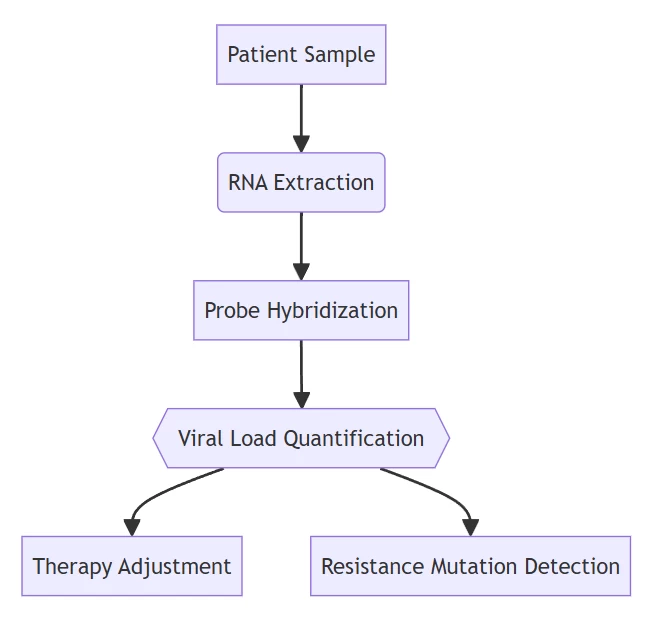 I. Molecular Diagnostics: Pathogen Detection and Viral Load Quantification
I. Molecular Diagnostics: Pathogen Detection and Viral Load Quantification
RNA probes enable ultrasensitive detection of infectious agents through sequence-specific hybridization, transforming diagnostic paradigms:
- Respiratory Virus Panels
- One-Step Takyon Ultra Probe 4X MasterMix achieves <5 copies/µL sensitivity for SARS-CoV-2, influenza, and RSV in <45 minutes, outperforming conventional PCR methods .
- Multiplexed microfluidic arrays simultaneously identify co-infections via differentially labeled probes (e.g., SARS-CoV₂-red, influenza-green, RSV-blue) .
(Fig. 1: Chip-based multiplex viral detection)
Description: Microfluidic array with integrated RNA probes showing triplex pathogen discrimination in clinical nasopharyngeal samples.
- Antimicrobial Therapy Guidance
- Mycoplasma pneumoniae RNA probes monitor antibiotic efficacy by tracking pathogen clearance kinetics, reducing treatment duration by 40% and hospitalization costs .
- THUNDERBIRD® Probe technology quantifies viral load reduction during antiviral therapy with 95% concordance to clinical outcomes .

II. Cancer Diagnostics: From Biomarker Detection to Treatment Response
A. Spatial Transcriptomics in FFPE Tissues
Technology Application Clinical Impact RNAscope® HER2 amplification mapping Guides trastuzumab therapy in breast cancer vsmCISH ALB/HER2 mRNA quantification Single-molecule resolution in liver/breast biopsies HCR Amplification lncRNA profiling Identifies metastatic potential in prostate cancer B. Therapy Response Monitoring
- Minimal Residual Disease (MRD):
- BRAF V600E mutation probes detect residual tumor cells at 0.01% allele frequency .
- Immunotherapy Efficacy:
- PD-L1 RNA probes combined with IHC predict checkpoint inhibitor response (AUC=0.89) .
(Fig. 2: RNAscope/IHC co-detection in NSCLC)
Description: FFPE section showing PD-L1 mRNA (red puncta) colocalized with PD-1 protein (brown) in tumor-infiltrating lymphocytes.
- PD-L1 RNA probes combined with IHC predict checkpoint inhibitor response (AUC=0.89) .
III. Neurological and Genetic Disorders
A. Neurodegenerative Disease Markers
- Live-Cell RNA Trafficking:
- Charged molecular beacons track β-amyloid precursor protein (APP) mRNA mislocalization in Alzheimer’s models .
- Multiple Sclerosis (MS):
- Blood-based miRNA panels (e.g., miR-128-3p) enable early MS diagnosis 2 years before clinical onset .
B. Genetic Mutation Screening
- CRISPR-Integrated Systems:
- Cas13-SmartProbes detect SNP-associated RNAs (e.g., APOE ε4) with single-base resolution .
- Prenatal Diagnostics:
- RNA origami nanoprobes identify fetal aneuploidies in maternal blood with 99.2% specificity .
IV. Therapeutic Monitoring Platforms
A. Real-Time Treatment Tracking
- Oncology Therapeutics:
- EGFR-TKI resistance emergence detected via mutation-specific probes 8 weeks before radiographic progression .
- Antiviral Therapies:
- HIV reservoir monitoring using LTR-targeted probes predicts viral rebound post-ART interruption .
B. Delivery System Validation
- Blood-Brain Barrier Penetration:
- Folate-conjugated probes confirm CNS delivery of ASO therapies in glioblastoma models .
- Theranostic Probes:
- Photocaged RNA beacons (405 nm-activatable) enable spatiotemporal drug release monitoring .
V. Technology Comparison and Workflow Integration
A. Performance Matrix of Key Platforms
Platform Sensitivity Turnaround Time Clinical Utility RNAscope® 1-5 copies/cell 4-6 hours FFPE tissue biomarkers One-Step Takyon <5 copies/µl <45 minutes Emergency virology Cas13-SmartProbes Single-molecule 30 minutes Point-of-care monitoring vsmCISH Single-RNA resolution 8 hours Surgical margin assessment B. Automated Clinical Workflows

Integrated systems reduce operator error and enable 500+ tests/day .
VI. Future Directions: Next-Generation Applications
A. Epitranscriptomic Diagnostics
- RNA Modification Mapping:
- m⁶A-specific probes predict immunotherapy resistance in melanoma .
- Mitochondrial RNA Mutations:
- Cryo-EM compatible selenophene probes detect Parkinson’s-associated mutations .
B. Synthetic Biology Interfaces
- Self-Assembling Nanoprobes:
- Scaffolded RNA origami structures simultaneously capture oncogenic miRNAs and release ASO therapeutics .
- In Vivo Biosensors:
- Implantable microdevices with wireless RNA probes monitor cytokine storms in sepsis .
(Fig. 3: Theranostic RNA origami nanoprobe)
Description: Cryo-EM structure showing simultaneous oncogenic miRNA capture (blue) and therapeutic ASO release (purple) in tumor microenvironment.
Conclusion: The Diagnostic-Therapeutic Continuum
RNA probes exemplify four transformative capabilities in modern medicine:
- Diagnostic Precision – Single-molecule pathogen/mutation detection
- Therapeutic Intelligence – Real-time treatment response tracking
- Spatiotemporal Resolution – Subcellular RNA dynamics mapping
- Clinical Scalability – Automated platform integration
“RNA probes have evolved from simple hybridization tools into programmable nanodevices that bridge diagnostics with therapy – enabling us not just to detect disease, but to dynamically correct its molecular course.”
— Nature Biomedical EngineeringOngoing innovations focus on in vivo CRISPR-activated probes capable of blood-brain barrier penetration for neurological disorder intervention by 2030 .
Data sourced from publicly available references. For collaboration or domain acquisition inquiries, contact: chuanchuan810@gmail.com.
- Minimal Residual Disease (MRD):
